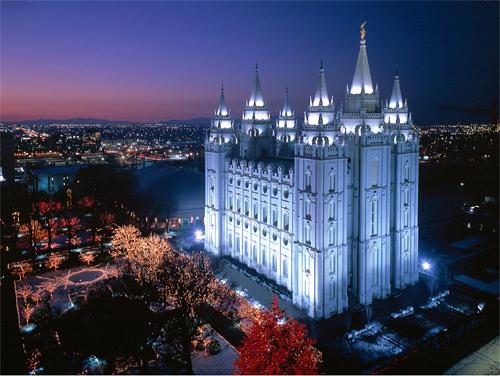I recently read an article in which the author said Mormons worshipped Mormon and Jesus both, which he felt proved Mormons aren’t Christians. The writer hadn’t done his homework. Mormons—a nickname sometimes given to members of The Church of Jesus Christ of Latter-day Saints—do not worship Mormon. They believe he was a real person, but he was a prophet, not a god and Mormons think of him in the same way they think of Moses or Noah. His story is an interesting one that illustrates a true Christian life. However, the true name of the Church defines whom we really worship.
 The misconception comes from the title of a book of scripture Mormons use in addition to the Bible. It is called the Book of Mormon and is a second witness of the divinity of Jesus Christ. Because the events described in it largely took place somewhere on the American continent, it helps to prove Jesus really did live and that He really was resurrected, since He visited them after His death. It makes it clear Jesus was not just the Savior of a tiny group of Christians in the Holy Lands, but of all people everywhere.
The misconception comes from the title of a book of scripture Mormons use in addition to the Bible. It is called the Book of Mormon and is a second witness of the divinity of Jesus Christ. Because the events described in it largely took place somewhere on the American continent, it helps to prove Jesus really did live and that He really was resurrected, since He visited them after His death. It makes it clear Jesus was not just the Savior of a tiny group of Christians in the Holy Lands, but of all people everywhere.
The book is named after Mormon not because the book is about Him, but because he, and after his death, his son, condensed the writings of the prophets who contributed to the book and put it into the form Joseph Smith received from Mormon’s son Moroni, who was by then an angel. Because the Book of Mormon is so well-known, non-members started calling members of the Church of Jesus Christ of Latter-day Saints Mormons—and sometimes we do it ourselves, although it isn’t really the correct name.
When Mormon was ten years old, a prophet named Ammaron hid the records in a hill. Each prophet had been required to write a history of his people and their dealings with God. Now a war was about to start and they needed to keep the records safe. Ammaron went to Mormon and said, “I perceive that thou art a sober child, and art quick to observe.” He instructed Mormon to retrieve the records from their hiding place when he was twenty-four years old. In the meantime, he was to pay attention to the history of his people so that when he got the records, he could add to them. Since these records were kept only by prophets, this was effectively his call to be the next prophet. However, he was only to take one set of records and leave the rest. These records were engraved on brass plates.
At the time Joseph Smith translated the Book of Mormon, it was believed ancient people had not kept records on metal plates. Today, records kept on metal plates have been found and dated into ancient times.
When Mormon was eleven, his family moved to a place called Zarahemla. The wars began and the people became very wicked. At age fifteen, Mormon, still a serious young man, wanted to preach to the wicked, but God would not allow it. They were too wicked and would not have listened to him. In fact, such preaching might have put him in danger and prevented him from carrying out God’s plan for Him.
The next year, even though he was only sixteen, he was chosen to lead his people in battle. He was tall for his age and an imposing figure. The battles didn’t always go well. The people had been promised they would always be protected when they obeyed God, but Mormon’s people, the Nephites, did not, so their enemies, the Lamanites were able to experience some success. Mormon worked to get all the Nephites gathered into one place so it would be easier to protect them.
In time, the Nephites became frightened by the wickedness of the world and began to express sadness over the ways of the world. Mormon was overjoyed by this, being not just their military leader, but also a spiritual leader. He hoped, with the optimism of youth, that they were sad for their own contributions to the world’s evil, but he soon realized they were only unhappy God wasn’t protecting them in their wickedness. They were not interested in repenting, only in getting protection they didn’t deserve any more than their enemies did. They wanted God to make them happy while they continued to sin.
In time, they were forced to flee, and as Mormon reached the age of twenty-four, the age he was commanded to retrieve some of the records, he found himself near their hiding place. He dug up the records and recorded the wickedness and trials of his people.
He continued to lead his people in battle, but he noted that they were rejecting the opportunity to have God’s help. However, they eventually managed to work out a treaty with the Lamanites and regain some of their lands and did so with God’s help, despite their unworthiness. With a ten-year break in the fighting, Mormon helped them prepare for the next battles, and tried to help them understand they survived only because God stepped in. They didn’t see things that way, however.
When war began again and the people began bragging they were winning entirely due to their own brilliance, Mormon decided he’d had enough. He refused to lead them any longer. They were unwilling to repent and to live the gospel of Jesus Christ. Year after year, the Nephites battled the Lamanites. Finally, when Mormon, still an observer and their prophet, even though they were ignoring him, saw the city was about to be overtaken, he returned to the hill and retrieved all the records to protect them. At this point, Mormon agreed to once again be their military leader.
At this time, a great battle was scheduled between the two groups. Mormon, now growing old, understood it would be the final battle and the end of a once-great civilization. He was, remember, a prophet. He completed the records and hid them in the Hill Cumorah because God had commanded him to protect them from the Lamanites, who wanted to destroy them. He gave a few plates to his son, Moroni, but the rest were hidden.
The majority of the Nephites, once God’s people, were killed in this battle. Those who survived were forced into hiding, but one by one, they were found and killed. Eventually, Mormon was killed.
In time, his son, Moroni, was the last remaining Nephite, the only good person left in his part of the world. The Lamanites had become evil beyond measure and were focused entirely on murder, even of their own people. Hidden away, the teenage Moroni worked to condense the records to manageable size and then hid them away. He fled and traveled for many years. Eventually he secretly returned and added more to the record before again hiding them and leaving. His story, which he shares in the Book of Mormon, is one of the most moving stories ever written, that of a teenager who has lost his entire family and all his friends and who remains alive only to do God’s work.
Although you might not have heard of Moroni, you may have seen the angel of the statue that appears atop most Mormon temples. This is a representation of Moroni, who would return as an angel to tutor Joseph Smith prior to the restoration of the gospel and who would lead Joseph to the records for which he paid such a great price.
About Terrie Lynn Bittner
The late Terrie Lynn Bittner—beloved wife, mother, grandmother, and friend—was the author of two homeschooling books and numerous articles, including several that appeared in Latter-day Saint magazines. She became a member of the Church at the age of 17 and began sharing her faith online in 1992.






